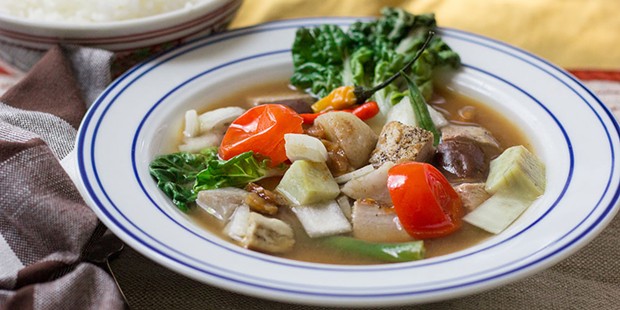[
{
"name": "Top Stories Video Pair",
"insertPoint": "7",
"component": "17087298",
"parentWrapperClass": "fdn-ads-inline-content-block",
"requiredCountToDisplay": "1"
}
]
Half the population of Humboldt has worked at Ramone's Bakery and Cafe at some point in their life, myself included. I worked as line cook, caterer and the occasional cookie decorator during holiday seasons. The schedule was flexible and co-workers were family; they could be annoying and have issues but you loved them nonetheless. And there were always open arms for you to come back to if you left (on good terms). It's almost like being a born-again Christian except with less Jesus, more weekend work hours and a lot of gluten and coffee. After a 14-month-long break from working at Ramone's, I made my glorious return to the catering team in 2014. As I walked into the bakery to start my first-ish day, the lead baker looked straight into my eyes with a deadpan expression and said, "They always come back." I was shook.
My main task for Ramone's was making a giant batch of soup that would be sent out to all locations and the catering manager offered me creative freedom. I had just moved back from the South Bay, one of the most diverse parts of the Bay Area. It was a place that offered so many Southeast and South Asian options when it came to dining and I was already missing so much of that. I realized I had the opportunity to bring some of those flavors back with me. Ramone's already had a head start with the African peanut soup and I added vegetarian yellow curry and chicken pozole verde. I'm still proud of the following they gained.
I often wish I had experimented more with soups from other regions, such as the Philippines, but I felt I needed to try it first, as I did with the yellow curry and pozole, from those who knew it best. Thankfully, a wonderful new Filipina friend of mine, Vivian Morales, had recently honored me with her Filipino cooking. Since then, I've been obsessed with Filipino food: everything from sweet, icy halo-halo to buttery señorita bread and all things purple ube yam. Luckily enough, she's offered us a recipe of her version of sinigang, a stew with a bright tang, thanks to the tamarind base. Humboldt is getting pretty chilly and wet, so this is a delicious dish to make on those rainy days and share with a large group. It's best served hot from the pot and over freshly cooked rice.
Pork Sinigang
You can get tamarind concentrate in powder form or a paste if fresh tamarinds aren't available. If you can't find that, mix 2 tablespoons of an acid, such as balsamic or white vinegar, with 1 tablespoon of honey and a touch of salt to create a similar umami flavor. Serves 15-20.
3 tablespoons tamarind concentrate
2 tablespoons fish sauce
1 liter soup stock
10 cloves garlic, minced
2 pieces ginger, slivered
1 Spanish onion
2 tomatoes
15 shishito peppers
1 Japanese eggplant
2 taro roots
½ bunch water spinach (or any hearty leafy greens, like bok choy)
½ bunch yardlong green beans (or other green beans)
1 daikon or jicama
2 pounds pork shoulder, cut into 1-inch cubes
6 tablespoons vegetable oil or lard
1 lemon (optional)
16 ounces water or stock
Salt and pepper, to taste
3 bird's eye chilies, whole (optional)
In a pan over medium heat, warm 2 tablespoons oil and brown the pork. Set the browned meat aside.
Dice all the vegetables to 1-inch pieces, with the exception of the shishito peppers.
Heat 4 tablespoons of oil in a stock pot over medium heat and sauté the garlic, onion and tamarind concentrate with a pinch of salt and pepper. Keep stirring until the garlic and onion are tender and covered in the tamarind paste. Add the taro, jicama and green beans. Stir the vegetables until all are coated with the tamarind mixture.
Drizzle in the fish sauce, then add the tomatoes and the water or stock. Bring it to a boil for 1 minute, then let it simmer on medium-low for 20 minutes. Be sure to keep the stew at a low simmer for the rest of the cooking time. Add the water spinach and, when it's tender, add the browned pork and optional chilies. Reduce the heat to low and let it simmer gently for another 5 to 10 minutes. Optional: Add more vegetable broth or water for a thinner soup. Squeeze 1/2 of a lemon into to the stew for a tangier flavor. Let it sit for 5 minutes. It is ready to serve when the taro is in between waxy and tender — you should be able to easily poke a toothpick all the way through without the taro disintegrating. Turn off the heat and let the soup sit uncovered for 30 minutes to 1 hour, allowing the flavors to steep. Serve over white jasmine rice with soy sauce or a bottle of Maggi Seasoning on the table.
Malina Syvoravong is a Humboldt native who is currently living in Oakland, obsessed with skincare and working as a professional stylist/fruit polisher.
Speaking of...
-

It's Cold Outside, Let's Make Soup
Dec 2, 2021 -

The Soup Doctor
Sep 23, 2021 -

Lentils: The Great Leveler
Mar 25, 2021 - More »
more from the author
-
Cambodian Community, Doughnuts and Prahok
And a Khmer eggplant and pork smoke-out
- Nov 8, 2018
-
The Bird and the Brine
A lesson in making the best chicken ever
- Sep 6, 2018
-
Elegant Macerated Strawberries
And the call of the Saechao's Farm stall
- Jul 5, 2018
- More »

































